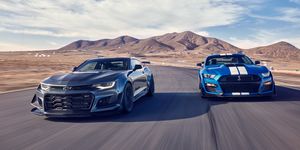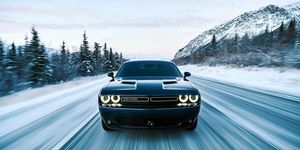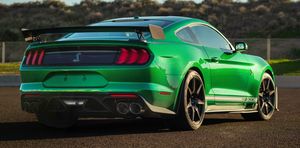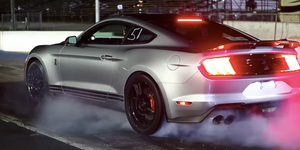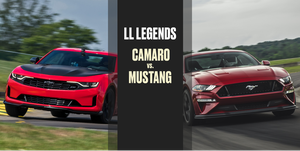In previous incarnations of this journal, the procedure for writing a headline for a comparison test similar to this one would have been to add up the peak horsepower of all the participants, add an exclamation point or two or three, and be done with the thing. But in these more enlightened times, simply typing “2207-hp Smackdown!” just doesn’t cut it.
Why, just last month, we estimated Car and Driver‘s carbon footprint. If you didn’t catch that piece, know that it’s sasquatch large. So instead, we’re starting this 2207-hp comparo by noting that the 797-hp Dodge Challenger SRT Hellcat Redeye Widebody is saddled with the lowest gas-guzzler tax of the three cars, at $1700. The feds have decided that buyers of the automatic-equipped Chevrolet Camaro ZL1 1LE need to pay $2100 because of its thirst. Choose the new Ford Mustang Shelby GT500 and you’ll need to pony up $2600. In our driving, the trio averaged less than 14 mpg. And that’s not including the tanks of fuel these vehicles mainlined during performance testing and hot lapping at a racetrack. Goodness gracious.
These cars live in an alternate universe where downsized engines and hybrid this and that simply do not exist. Hell, two of the three engines in this comparison test have pushrod valvetrains (incidentally, those two delivered slightly better fuel economy than the smaller-displacement DOHC engine). Instead of turbochargers, they all compress air with superchargers, a type of performance enhancer nearly as old as gas-powered engines. And they are, it must be said, glorious and garish in equal measure.
Leading the old-school charge is the Hellcat Redeye Widebody. It’s not just the look that’s old school; the chassis underneath the Redeye dates back more than a decade. But Dodge has made a virtue of the Challenger’s antiquated chassis and tough-guy looks with increasingly outrageous editions. Here we have the most outrageous, most capable version currently available, with nearly 800 horsepower and tacked-on fender flares to cover its fat tires. Our test car came with optional summer-only Pirelli P Zero PZ4 rubber ($695) and a shorter, 3.09:1 rear axle ($1095). Otherwise, the options—which take the Challenger’s as-tested price to $92,785—are all comfort and convenience items.
The last two generations of the Camaro also had a bit of retro at their core, but with this one, Chevy has turned its classic pony car into a modern sports car. For this test, we opted to include the 650-hp ZL1 model and spec’d the $7500 track-focused 1LE package, which adds a road-racing-style wing and front dive planes to the increasingly futuristic-looking Camaro. We also specified the 10-speed transmission ($1595) to better match the automatic-only competitors.
The star of this particular show, the new Mustang Shelby GT500, is Ford’s bid to dominate the class. Its 760-hp supercharged DOHC 5.2-liter V-8, which is bolted exclusively to a Tremec-sourced seven-speed dual-clutch automatic, has certainly raised a few eyebrows in this rarefied segment. But we’ve seen big horsepower from GT500s before. What we haven’t seen is a balance of power and handling. Ford promises that it’s different this time. To buttress that claim, the company fitted our test car with the $18,500 Carbon Fiber Track pack. It includes carbon-fiber wheels and a big manually adjustable wing along with some special trim.
With these three powerhouses, we were destined to burn some fuel—okay, a lot of fuel. But we decided to make the most of our carbon output by taking these cars to the wide-open spaces and mountain roads near Death Valley National Park in California and exploiting them to the maximum in the only place where one can do such a thing: the racetrack. Because 2207 horsepower!
3rd Place:
Dodge Challenger
Highs: Muscle-car retro done right, a usable rear seat and trunk, comfy ride, WHINE.
Lows: Terrible seats, wobbly body, dead steering, more power than it’s prepared to deal with, WHINE.
Verdict: Plays to its own drummer, loudly.
The Dodge Challenger SRT Hellcat Redeye Widebody tested here was equipped with a trunk-mounted subwoofer, whereas the GT500 came with carbon-fiber wheels and without rear seats. If there is a clearer indication of how the Challenger differs from the other combatants, our horsepower-addled minds cannot conceive of it.
Sure, the thumper is optional (part of a $1595 audio package), but we can’t imagine the Challenger without it. At least not after technical editor David Beard found a radio station playing appropriately bass-heavy jams. At sufficient volume, the entire rear end falls into vibratory ecstasy. We popped the trunklid to find Cheetos crumbs bouncing to the bass and beef jerky fluttering across the floor. It was bumpin’ in there. Which reminds us: Sorry about the mess in the trunk, Dodge.
Everything about the Challenger SRT Hellcat Redeye Widebody is big and bodacious. Hell, it takes five words just to name it. Its steering wheel appears to come directly from a clipper ship. Open its massive twin-nostril hood and it looks like there’s a large Zero Halliburton aluminum suitcase mounted atop the engine. That’s the 2.7-liter supercharger. But you don’t have to lift the hood to know it’s there. It is always whining, loudly. At 4529 pounds, the car is 643 pounds heavier than the Camaro ZL1 1LE. Thanks in part to its cast-iron engine block, it carries 57.0 percent of its heft over the front wheels. And lest we forget, with 797 horsepower, the Challenger is the most powerful vehicle here by some margin. But not everything about this car is huge. Grip from its 305/35ZR-20 tires is, whether in a straight line or through a corner, the lowest. Both the Ford and Chevy wear racetrack tires that offer better launch traction and way more bite in turns. Consequently, the Dodge wound up being the least quick of the group.
Contributor Scott Oldham, a vintage-muscle-car fan and our lead Hellcat cheerleader, noted that he could place the broad-of-beam Redeye Widebody exactly where he wanted to on the road. “Precisely on the edge of the yellow line,” he said. Maybe that’s true, Oldham, but when the left tires are precisely on the edge of the yellow line, the right-side tires are pretty much on the white line. On narrow roads, it’s not so much a matter of placing the car, but of wedging it between oncoming traffic and guardrails.
Point is, the Challenger shouldn’t be much of a challenger in this group. From acceleration to braking to roadholding, the Redeye did, indeed, bring up the rear. Yet, it has charm, and charm goes a long way. Once you get used to the nautical body motions and vague steering, this car is old-school fun. Even on Willow Springs International Raceway, where our expectations of the Dodge were low, it proved a hoot. The broad front rubber of the Widebody means that the Challenger actually turns pretty well and evidences balanced handling.
And the Redeye rules the highway. It settles nicely into a cruise, and its ride is downright comfy compared with those of the track rats that make up the balance of this test. The expressway serves as the Challenger’s ultimate arena. In an impromptu rolling drag race from 50 mph, it is nearly unbeatable. Just ask Oldham.
And with the Challenger SRT Redeye Widebody, Dodge has tapped into the country’s latent muscle-car affection. It is retro done right. Sure, the seats are terrible, unsupportive things. And $92,785 seems like an awfully high price to pay for a remastered muscle car. But the Challenger defines its own unique measure of success and then nails it, knocks it down, and does a lurid burnout on top of it. It couldn’t care less about any Mustang or Camaro.
2nd Place:
Ford Mustang
Highs: An engine that just keeps on giving, snappy dual-clutch gearbox, a track-day joy.
Lows: A fuel tank that just keeps running dry, numb steering, costly.
Verdict: A GT500 to make you forget about all those old push-pig GT500s.
Down the front straight at Willow Springs, traveling at 150 mph, the GT500 broadcasts a wall of sound so dense, menacing, and percussive that it would knock the wig right off a trembling Phil Spector.
At full revs, chugging high-test, the GT500 is an event, an automotive happening. But it’s a limited-time offer because, with its mighty thirst and relatively small fuel tank, it seems to spend as much time at the pump as it does on the track.
But fury takes energy. And the 760-hp supercharged 5.2-liter V-8 is nothing if not furious. Unlike the two other cars here, it’s a revver. You dip into the throttle and think, “Well now, that’s quite a lot of thrust.” But then you keep your foot in it and pass through the following escalating stages: “Oh, wow,” “Holy shit,” and finally, “I’m gonna hurt myself here.” But for standing-start acceleration, all that might is a bit too much. Despite its gooey 315/30ZR-20 Michelin Pilot Sport Cup 2 rear tires, programmable launch control, and quick-shifting seven-speed dual-clutch, the GT500 simply can’t harness its full power—assuming the ground is not covered in sticky traction compound, such as at a drag strip. We managed a 3.6-second sprint to 60 mph. That’s a solid number, but it’s not as quick as the run in the Camaro, which has 110 less horsepower. By 100 mph, though, the Ford is quicker than the Chevy by 0.3 second, and by 160 mph, it’s more than five seconds quicker. Its 132-mph trap speed in the quarter is ample proof of the Mustang’s power.
But power was never really the problem with previous GT500s, especially the last couple versions. The problem was always that the cars were, well, push pigs. No more. Clearly, the sticky Michelins have something to do with that. At Willow, the GT500 proved an excellent track car, particularly after we removed the rain tray from under the huge hood vent, fitted the included splitter wickers, and adjusted the wing to its high-downforce setting.
The GT500 is alive on the track. After only one session, it was identified as the car most likely to end up in the dirt. That’s not because of any failing on the part of the GT500. Rather, it’s because the Mustang goads the driver the most. Its failings on course were the same as those on the road: Its steering is disconcertingly numb, and it needed two fill-ups at the $7-per-gallon on-property gas pump, whereas the other cars needed only one.
Also on the problematic side of the register is its $93,870 as-tested price. But it is a hell of a thing—a decent-riding, mania-inducing, eardrum-puncturing thing. It’ll keep you pushing harder until you mess up or it runs out of gas. God bless it.
1st Place:
Chevrolet Camaro
Highs: Best real-world performance, most confident track-day tool, value.
Lows: The Camaro interior, head-splitting ride.
Verdict: The best modern muscle car is the least powerful one that also looks like your future robotic insect overlord. What of it?
Yeah, the Camaro ZL1 1LE is $16,800 less than the Challenger and $17,885 less than the GT500. And sure, that gave it a serious boost in our scoring. But its relatively modest price is only part of why this track-oriented Chevy took the honors here.
Our affection for the current-generation Camaro is well documented. It has the finest-handling, best-steering chassis ever shoved under a pony car. It is a machine of great precision and trustworthiness. Carrying the least weight and riding on Goodyear Eagle F1 Supercar 3R near-slicks, the Camaro manages the shortest stops from 100 mph (11 feet shorter than the GT500 and 35 less than the portly Challenger) and the most outright grip (a stunning 1.17 g’s on the skidpad). With a talented ‘shoe in control, the Camaro is quickest to 60 mph, a feat it manages in 3.4 seconds. At 11.5 seconds in the quarter-mile, it’s only a tenth off the much more powerful GT500 because one had traction and one did not.
At Willow, the Camaro’s electronically controlled limited-slip differential was able to sort out the axle lockup to better effect than the GT500’s Torsen diff. Its Performance Traction Management system, which controls the diff and stability-control settings, acts like a patient driving instructor, giving you a bit more leash each step up its settings. The 1LE’s steering fidelity allows the driver to monitor front-end-grip levels with unparalleled accuracy. It felt stable and in control at all times. Its tires never registered as greater than “warm” in the instrument-panel readout despite prolonged abuse (it was only 60 degrees that day, though). And unlike with the GT500, we didn’t need any tools to ready the Camaro for laps. It’s raring to go whenever.
This trait is almost always a good thing. It’s the nature of the specialized 1LE package. In addition to aero doodads and cosmetic touches, the 1LE package nets buyers the track tires and a retuned suspension with trick Multimatic-supplied spool-valve dampers. Because Chevy figures 1LE buyers know what they’re getting into, the company stiffens the suspension to a stunning degree. It was almost too stiff for bumpy Willow Springs. It was definitely too stiff for the lumpy desert roads outside Death Valley, where the Camaro’s unyielding suspension forced this writer’s head into contact with the roof three times in rapid succession. Perhaps slowing down would have somewhat mitigated the severity of the whacks.
Also, please add to this section of the story our usual complaints about the poor quality and tortured design of the Camaro’s interior. On the upside, this particular car came with the test’s best seats, and most of its touch points were covered in silky-soft synthetic suede. And as for the optional automatic, you can forget about using the shift paddles; this 10-speed’s shift programing is so spot on, it makes any manual control a moot activity.
Of the three, the Camaro is the most rewarding and confidence-inspiring to drive. That Chevy managed to achieve this performance with the least horsepower and the lowest sticker price reveals a variety of efficiency as difficult to achieve as miles per gallon, and ever so much more thrilling.
From the March 2020 issue.
Tell us what you think. Write to: [email protected] or join Backfires.caranddriver.com
Source: Reviews - aranddriver.com

